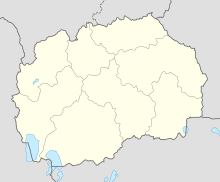Herakleia Lynkestis
Coordinates: 41 ° 0 ′ 39.6 ″ N , 21 ° 20 ′ 31.2 ″ E
Herakleia Lynkestis ( Greek Ἡράκλεια Λυγκηστίς or Ἡράκλεια Λύγκου ) was the capital of the Upper Macedonian landscape of Lynkestis . The ruins of the city lie on the southern edge of the modern city of Bitola in southwestern North Macedonia .
Herakleia was probably owned by Philip II between 359 and 356 BC. Founded when the king snatched Lynkestis from the Illyrians in several campaigns and firmly connected the landscape with Macedonia. The city was located on a small hill on the important east-west connection from Dyrrachion on the Adriatic via Lychnidos to Macedonia and Thrace . This route was later expanded by the Romans to the Via Egnatia . Another important road led to Stobi in Peonia . Both because of this convenient location and because of the excellent environment for agriculture, Herakleia quickly developed into the prosperous center of the Lynkestis.
During the Roman Civil War , Gaius Iulius Caesar established a supply base in Herakleia for his troops operating in the Balkans. After the war, Roman veterans settled here. Although the city experienced a new heyday during the Principate , as extensive excavations have shown, it is rarely mentioned by the ancient authors.
Emperor Hadrian had the theater of Herakleia built, whether there was a previous building is uncertain.
From the 4th century to the 6th century there are numerous names of bishops from Herakleia who took part in various councils and synods.
In 472 Herakleia was sacked by the Ostrogoths under Theodoric . This happened again in 479, although the bishop had tried to buy the city out. At the turn of the 5th to the 6th century, the city was rebuilt, but at the end of the 6th century it was captured by the Slavs , destroyed and then finally abandoned.
During excavations in the 1930s, 1960–1964 and 1970–1975, parts of the fortified acropolis , the theater, baths, two basilicas with late antique mosaics and the remains of some private houses were uncovered. The smaller basilica and the associated baptistery have been partially restored, as have the remains of houses from the Hellenistic era.
Most of the finds from Herakleia are kept and exhibited in the Bitola Museum.
literature
- Héraclée, 3 vols. Bitola 1961–1967. - excavation reports
- Аница Ѓорѓиевска: Христијанизацијата на Хераклеја Линкестис. [Битола & Софија] 1999.
- Г. Томашевиќ: Хераклеја Линкестис (= Heraklea Lyncestis). Bодич [ leader ]. Битола 1973.
- Fanula Papazoglu (ed.): Inscriptiones Lyncestidis, Heracleae, Pelagoniae, Derriopi, Lychnidi. (= Inscriptiones Graecae, Vol. 10: Inscriptiones Graecae Epiri, Macedoniae, Thraciae, Scythiae, Part 2: Inscriptiones Macedoniae, Fasc. 2: Inscriptiones Macedoniae septentrionalis). Berlin 1999. ISBN 3-11-016489-2
- Fanoula Papazoglou: Les villes de Macédoine à l'époque romaine. Athènes 1988. ISBN 2-86958-014-2
- James Wiseman: Herakleia under Latmos Caria, Turkey . In: Richard Stillwell et al. a. (Ed.): The Princeton Encyclopedia of Classical Sites. Princeton University Press, Princeton NJ 1976, ISBN 0-691-03542-3 .



